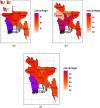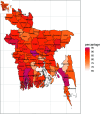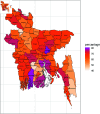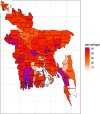Prevalence and determinants of violent disciplinary practices for children in Bangladesh: Evidence from a nationally representative survey
- PMID: 40779562
- PMCID: PMC12334003
- DOI: 10.1371/journal.pone.0329017
Prevalence and determinants of violent disciplinary practices for children in Bangladesh: Evidence from a nationally representative survey
Abstract
Violent discipline, characterized by the use of physical force resulting in bodily pain, discomfort, or resorting to scolding and emotional abuse to correct children's misbehavior, has gathered considerable attention due to its negative impact on children's development. This study aims to identify the prevalence and factors associated with different violent disciplinary practices toward children of 1-14 years age in Bangladesh. Utilizing data from the Multiple Indicator Cluster Surveys (MICS) conducted in 2019, this analysis, based on interviews with parents of 70027 children, focuses on three dependent variables measuring violent disciplinary practices: psychological aggression, physical punishment and any violent discipline. The independent variables considered include the child's age, sex, type of residence (rural or urban), division, education of mothers, child disability, ethnicity and wealth index. Logistic regression models were employed to find the relationships between these variables and different forms of violent discipline, including psychological aggression, physical punishment and any violent discipline (psychological aggression, physical punishment or both), among children in Bangladesh. The results reveal several significant associations with these disciplinary practices. Younger male children, with functional difficulties, those from urban residence and poorer households, residing in the central and southern regions of the country (Khulna, Chattogram), having primary educated mothers and belonging to the Bengali households are at higher risk of any form of violent discipline including psychological aggression, physical punishment. Significantly, our study unveils a strong correlation between any violent discipline and psychological aggression, highlighting that Bangladeshi parents predominantly employ psychological aggression as their primary mode of disciplinary practice. The findings underscore the importance of activating child protection laws and implementing continuous training programs for parents to promote positive parenting practices. To mitigate the use of violent discipline in Bangladesh, the study suggests focusing on improving parental education levels and addressing economic conditions.
Copyright: © 2025 Rashid Mim, Shahed Masud. This is an open access article distributed under the terms of the Creative Commons Attribution License, which permits unrestricted use, distribution, and reproduction in any medium, provided the original author and source are credited.
Conflict of interest statement
The authors have declared that no competing interests exist.
Figures





Similar articles
-
Prevalence of Parental Violent Discipline Toward Children: Findings From A Portuguese Population.J Interpers Violence. 2024 May;39(9-10):1881-1904. doi: 10.1177/08862605241230552. Epub 2024 Feb 13. J Interpers Violence. 2024. PMID: 38348947 Free PMC article.
-
Association Between Mothers' Life Satisfaction, Happiness and Child Discipline Practices: Evidence From a Nationally Representative Survey.J Interpers Violence. 2025 Jul 23:8862605251353469. doi: 10.1177/08862605251353469. Online ahead of print. J Interpers Violence. 2025. PMID: 40698384
-
Surveillance for Violent Deaths - National Violent Death Reporting System, 48 States, the District of Columbia, and Puerto Rico, 2020.MMWR Surveill Summ. 2023 May 26;72(5):1-38. doi: 10.15585/mmwr.ss7205a1. MMWR Surveill Summ. 2023. PMID: 37220104 Free PMC article.
-
Parent training interventions for Attention Deficit Hyperactivity Disorder (ADHD) in children aged 5 to 18 years.Cochrane Database Syst Rev. 2011 Dec 7;2011(12):CD003018. doi: 10.1002/14651858.CD003018.pub3. Cochrane Database Syst Rev. 2011. PMID: 22161373 Free PMC article.
-
Family-centred interventions for Indigenous early childhood well-being by primary healthcare services.Cochrane Database Syst Rev. 2022 Dec 13;12(12):CD012463. doi: 10.1002/14651858.CD012463.pub2. Cochrane Database Syst Rev. 2022. PMID: 36511823 Free PMC article.
References
-
- Straus MA, Mattingly MJ. A short form and severity level types for the Parent-Child Conflict Tactics Scales. Durham, NH: Family Research Laboratory, University of New Hampshire. 2007. https://api.semanticscholar.org/CorpusID:16511623https://api.semanticsch...
-
- Alampay LP. Parenting in the Philippines in parenting across cultures: childrearing, motherhood and fatherhood in non-western cultures, H. Selin and P. Schvaneveldt (Eds.). The Netherlands: Springer, pp. 105–121. 10.1007/978-94-007-7503-9_9 - DOI
-
- Elsaied H, Alsehly A. A study of child physical abuse. Egypt J Psychiatr. 2017;38(2):120. doi: 10.4103/1110-1105.209674 - DOI
MeSH terms
LinkOut - more resources
Full Text Sources
Medical

